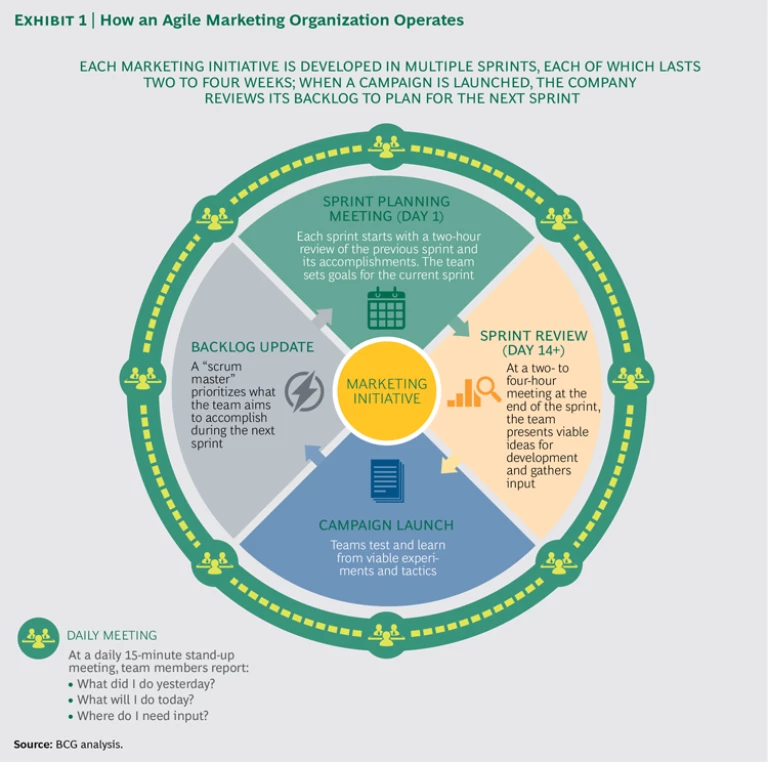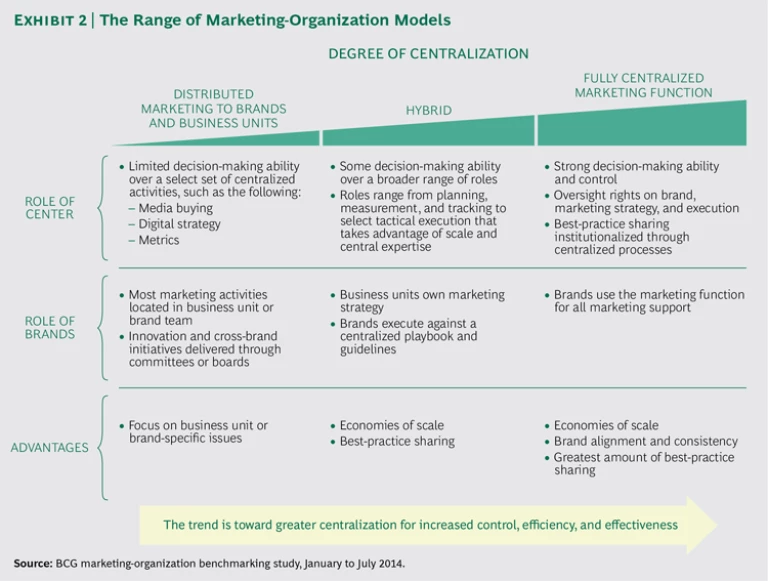The job of top marketers has grown exponentially bigger and harder given today’s digital reality. Traditional skills such as creativity and brand building, although still important, no longer suffice. Mandates have broadened. And marketing has become much more of a science, requiring technical, data-crunching abilities. With digital channels and tools constantly emerging, marketing organizations must become (to borrow a term from the world of software development) more agile, iterating much more quickly to adapt to rapidly changing conditions.
To increase their agility, chief marketing officers (CMOs) require very different capabilities and structures than were needed in the past. Capabilities include new talent in agile development, big data for consumer understanding, programmatic buying, and branded content, as well as redefined roles for existing talent in areas such as marketing effectiveness analytics, marketing innovation, and agency management. At the same time, organizations must consciously build structures that align with their key business objectives. Organizations that aren’t able to build these capabilities and structures over the next year will, we believe, fall behind their competitors.
To understand the organization models necessary in this fast-moving digital era, The Boston Consulting Group interviewed CMOs and senior marketing executives at approximately 30 major companies and benchmarked more than 70 companies in a variety of sectors, including consumer, financial services, travel, retail, media, technology, and automotive. Nearly half of the companies had revenues of $10 billion or more. The results confirm what we have observed through our daily work with clients: Marketing organizations have fundamentally changed. Leaders must raise their game.
The Capabilities Needed for Success
Companies are facing a host of new and different challenges since our last study of senior marketers, in 2012. (See Marketing Capabilities for the Digital Age, BCG report, January 2012.) Three years ago, companies recognized that they had a big gap in their capabilities related to social media and community management. Today, these areas are still important, but companies appear to have mostly built the necessary capabilities. The focus now has expanded to different areas, including big data, branded content, videos, and apps.
In our current study, CMOs said that their greatest struggles are with organizational silos and ownership issues, the lack of technology- and data-savvy talent, and the impact of scaling up their digital efforts. Many respondents reported difficulty recruiting and retaining marketers with the new skill sets required. “Turnover can be high, especially for roles in emerging technologies and spaces,” according to one top marketer. Said another, “We don’t have enough staff for breakthrough and new-capability work—only the basic running of the day to day.”
In our look at best practices across the dozens of companies we studied and from our work leading the transformations of many marketing organizations, we have uncovered seven emerging capabilities that marketing groups must develop immediately.
Agile Development. Many best-in-class marketing organizations act more like technology companies, using agile techniques borrowed from the software development world to speed up the development of initiatives and timelines. (See Exhibit 1.) As an example, some leading organizations are appointing a “scrum master” who leads rapid “sprints” to develop integrated marketing initiatives, apps, and websites. Scrum masters often divide work into smaller pieces for rapid development.
Finding people with capabilities such as these can dramatically accelerate the pace at which marketing organizations innovate. No longer can marketers spend six months developing and testing a campaign. As cycles grow much more rapid, people and workflows must adapt.
Big Data for Consumer Insight. Today’s marketing organizations are awash in data generated from such disparate sources as websites, social media, sales, mobile devices, and customer-relationship-management systems. However, we learned that companies cannot always find the people they need to put all this data to work. Thirty-five percent of the companies we studied reported that a lack of dedicated, qualified analysts and data experts was hindering their efforts. “On the people side, I don’t have the analysts and data crunchers who can work with big data,” said one senior marketer. As a result of this and other gaps, 60 percent of participants in our study either do not collect data or significantly underuse the data they do gather. Of those that do use big data, business units often lack focus on the objectives they are trying to achieve from tracking data, ending up with a lot of nice-to-haves that do not produce results.
Whether they have large or small data organizations, best-in-class analytics teams are characterized by specialized analytical expertise to generate consumer insights. Teams at most large organizations we looked at are made up of 20 to 30 people. Said the head of retention at a top telecom company: “If I had to cut my team by 80 percent, the last people to leave the building would be my analytics people.” One new role we uncovered is that of the “data storyteller,” who can effectively communicate data-based insights in the form of stories and narratives that will resonate inside and outside the organization. It can be a challenging role to fill.
Marketing-Effectiveness Analytics. Techniques are evolving beyond the traditional marketing-mix models (MMMs) used to optimize the return on marketing spending across mass-media channels and to link marketing activity to sales. Advanced MMM employs more-sophisticated statistical methodologies, is built at a more detailed level of the market or product, captures direct and indirect effects, and includes many more variables than in the past. Best-in-class organizations are also using emerging methods such as digital attribution models to determine how to assign credit for online sales and conversions to the wide range of digital touch points through which customers experience a brand.
Although some companies have not yet begun to use marketing effectiveness analytics, many others are finding themselves drowning in analyses that do not necessarily lead to smarter decision making. The best companies are working with a suite of analytics providers to create a “common currency” for measuring marketing, and they are embedding these metrics into their decision-making processes broadly.
Programmatic Buying. We interviewed executives at several companies that are moving significant dollars to programmatic buying in 2015. “Programmatic buying is important to us,” said the director of integrated marketing at a fast-moving consumer goods company. “It helps to keep costs down while allowing us to retain flexibility.” Procter & Gamble and American Express have publicly announced that they plan to shift at least 50 to 70 percent of their digital-media purchases to programmatic techniques. Companies are relying on programmatic buying even for their traditional-media purchases in print and TV.
Despite the rapid adoption of this technique among leading companies, only about a third of those whose representatives we interviewed were doing programmatic buying in 2014. The rest lacked an understanding of its potential. Best-in-class companies are testing programmatic buying internally, while still looking to their agencies for guidance about how to use the technique to make buying more efficient.
Branded Content. Content strategies are rapidly evolving to adapt to an ever more fragmented ecosystem of platforms and channels—mobile, e-mail, interactive tools and Web experiences, videos and short films, and editorial content—in order to reach consumers with relevant information when, where, and how consumers prefer to engage. Most companies we studied are creating content to add value to their relationship with customers. What’s new is that they are trying to put a coherent strategy behind their effort and place experienced people in charge of it. “Content creation did not used to be a big focus for us, but now it is,” said the head of digital for a consumer goods company. “Now brands are more heavily investing in content.”
Specialized vendors—among them Contently, Flite, Water Cooler Group, and Tongal—are emerging to help brand teams find the capabilities they need. Best-in-class companies are employing content developers in their marketing teams in areas ranging from copywriting to in-house video production, often bringing in talent from traditional-media organizations such as Time, Inc., and Condé Nast. A key role on the content team is that of chief content officer, who is responsible for creating the company’s content across channels. The position has become a priority as marketers aim for a more cohesive content and storytelling strategy.
Marketing Innovation. Best-in-class organizations are launching innovation labs to stay on top of trends and experiment with new approaches. To “find the next Facebook,” they are getting as close as possible to those at the forefront of innovation. Organizations such as The Home Depot, Anheuser-Busch Companies, and Unilever are setting up shop in technology hubs like Silicon Valley, California, and Austin, Texas, launching venture capital funds and start-up labs to learn better ways to develop products and reach customers. Others have, within their marketing organization, dedicated teams that typically conduct pilots and measure their results before approving channels and platforms for wider marketing use and developing best practices for how to use them.
Nestlé has established an “innovation outpost” in Silicon Valley as well as “digital acceleration teams” in 13 markets to help deepen relationships with consumers in the digital world and respond to their needs more quickly. The innovation outpost aims to enhance existing partnerships with the world’s largest technology companies while seeking future partners among the thousands of small technology start-ups. “You can’t underestimate the importance of having an external presence in high-innovation, rapid-turnaround places like Silicon Valley,” says Mark Brodeur, global head of digital-marketing innovation and leader of the innovation outpost. “It’s both energizing and humbling, and in a short time we’ve built invaluable relationships with many of the players setting this tempo.”
Agency Management. A single agency of record, no matter how large, does not always have all of the capabilities that companies require. Marketers today must often work with a portfolio of diverse agencies to get the specialized expertise they need. We found that brand teams typically work with more than ten agencies or vendors. As a result, managers can often spend half their time or more overseeing outside companies.
To manage such a large portfolio of agencies in a scalable way, many best-in-class organizations have developed marketing operations roles, located in marketing, not in procurement. These roles often oversee planning and budgets, measure performance, and deal with contracting, negotiations, and reviews. Staff members can find agency-related cost savings by improving the efficiency with which marketers use agencies and vendors, such as by reducing multipliers, harmonizing rates, and optimizing nonbillable hours. Sometimes marketing-operations people manage media buying as well. Marketers have found savings of anywhere from 5 to 10 percent by putting these roles in place.
Building the Marketing Organization 2.0
Beyond building and strengthening capabilities, marketers need to consciously develop greater agility throughout their organization. To succeed in the fast-moving digital environment, we recommend, based on our work with leading organizations, that companies implement the following structural changes immediately.
Centralize the Right Activities. Many companies are seeking to centralize functions so that they can put in place better controls and create greater efficiencies. But they often are not strategic enough about what they centralize. In our study, we found that many companies are leaving savings on the table by not centralizing thoughtfully: they are missing out on creating economies of scale and are unable to take full advantage of best practices. (See Exhibit 2.)
Create the Right Structure. There is no one-size-fits-all organization structure. Effective companies create a structure that aligns with their major business objectives and then scale that structure. Companies most commonly organize themselves according to one of five potential dimensions, each with important trade-offs. (See the slideshow.) Most marketing organizations are a combination of at least two of these dimensions, with one being dominant. Which one dominates often depends on the size of a company.
Redefine Roles and Talent Management. The talent landscape is changing rapidly in many marketing organizations: both new roles and redefined roles are needed. But all the required skill sets may not feasibly exist in the same person. To find the capabilities they need, companies must search nontraditional talent pools, such as content development talent from traditional publications.
When marketing is not working, marketing organizations usually know it. They struggle to find the new capabilities, as well as new organization structures, to be effective in the current environment. They sometimes have not fully thought through what to centralize and why. Their marketing organizations often operate in silos, cut off from the rest of the organization and its goals. They don’t necessarily have the right skill sets to operate well, let alone on the fly.
Marketing organizations need to evaluate their current capabilities and build those needed for the next generation of marketing. After taking stock of their current organization structure, they need to design their structure for increased efficiency and effectiveness. By taking a careful look at the areas, marketing organizations can respond with greater creativity and agility to changes in the business environment.







